How have I changed in three years? Have I improved or declined?
I pondered those questions in advance of the Lake Sonoma 50-mile race that took place Saturday, April 9. I was nervous, not so much about the competition—which was out of my league, attracting the country’s top ultrarunners—but about how I’d do compared to my younger self.
I raced the 2013 Lake Sonoma 50 and was elated with my prior finishing time of 9:36, as detailed in this earlier blog post. So my primary goal this year was to beat that earlier time—or at least match it—and avoid “blowing up,” because I need to build confidence for the June 25 Western States 100.
And I need to build confidence in life in general.
I’m struggling a bit with midlife transitions. I look in the mirror and see deeper wrinkles, blotchy sun spots and more gray hairs. In less than a year, I shifted from viewing myself as “close to 40” to “almost 50”; from a mom heavily involved with my kids and our local schools, to an empty-nester working independently and nearly full time. I don’t mean to suggest that the 50s are “old,” because they’re not; you’re not really old until you start acting old—I’m just adjusting to a new phase, triggered in part by my teenagers being more independent and spreading their wings at their boarding school.
So I really wanted to use Lake Sonoma 50 as a test of whether I had become faster and better. I needed to listen to what I tell my clients: “Believe in yourself. Trust your training.” I really needed to silence the self-defeating voice that says, “I was a lot faster in my 30s, and now I’m not …”
Objectively, I have been training well. And I hope I’m a better runner than I was three years ago, because in mid-2013—shortly after that strong Lake Sonoma 50 performance—I broke down with multiple injuries. I spent much of 2014 re-learning how to run with better form and making changes to my training. I also became a coach and learned from coaching others. Consequently, I approached this year’s Lake Sonoma 50 curious about how much training and improved biomechanics could offset age-related athletic decline.
Some race directors do a funny thing: They give friends the bib number that reflects their age. Lake Sonoma RD John Medinger gave me my age on my bib both years, which I appreciated.
So let’s cut to the chase.
The race unfolded as I hoped and planned. I did what I vowed in my last post to do:
- focus on wellness, sleep, and get everything ready several days in advance;
- travel to the race and go to the pre-race dinner in a calm manner, and not get all swept up and nervous by the pre-race hullabaloo and big personalities there;
- be relaxed and friendly at the starting line;
- run my own race and not feel competitive toward others, because this event is out of my league competitively, and my only competitor is the clock;
- run happy and stay positive;
- shift into high gear, dig deep and work my ass off in the final one-third.
Mission accomplished!
I stayed relaxed. This does not mean I took it easy; on the contrary, I ran hard, especially when the trail gave us smooth, runnable stretches. But I concentrated on keeping a relaxed upper body (instead of holding in tension) and running as efficiently as possible. I ran by feel instead of by a heart rate monitor and tried to achieve the feel of a steady trail marathon pace.
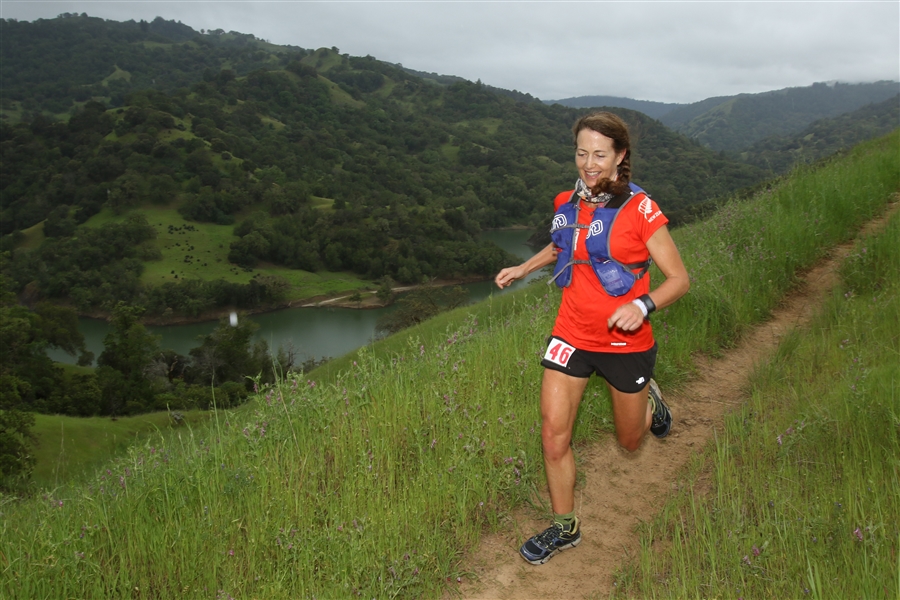
Somewhere in the first half of the race, on a pretty and easy stretch. (Photo by Facchino Photography)
I ran happy and positive. At aid stations, so many people cheered me on and made me feel great. People like Errol “The Rocket” Jones, Jason Koop, Chris Jones, Monica Morant, Judith Cernoia, Veronica Fujisawa, Meghan Hicks, Devon Yanko, Ethan Veneklasen, Bob Sheebest, Brian Mulholand, Scotty Mills and of course my UltraRunnerPodcast co-conspirator Eric Schranz.
I seriously loved going through aid stations because of that positive energy, which gave me a boost to run hard and happy to the next aid station.
I made a pace band with a three-tiered goal for finishing times: 10 hours (respectable), 9:30 (my true goal, to shave six minutes off 2013’s time), and 9 hours (over-the-moon aspirational but within the realm of possibility).
The pace band estimated times to aid stations; in the first half, I was reaching the aid stations on pace for close to a 9-hour finish, but I knew I’d likely slow down on the second half. Was I going out too fast? No, I felt good.
Going up the hill from the Mile 18 aid station, I put on my iPod for a mental boost up the first of three major climbs.
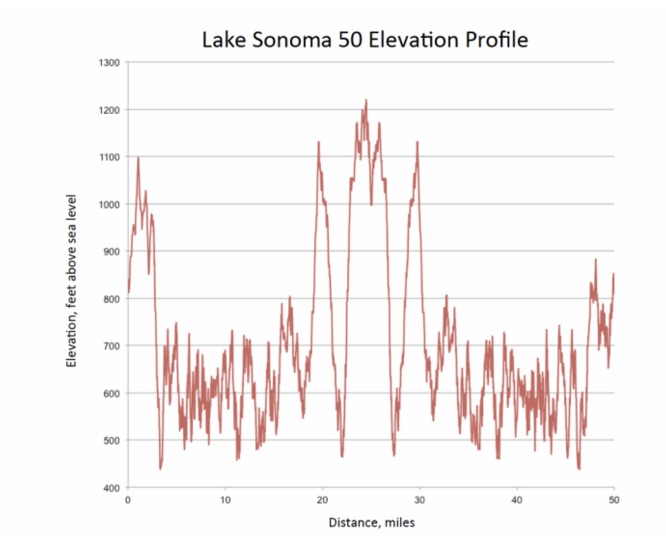
The LS50 elevation profile, with about 10,500 feet of climbing, featuring three big hills in the middle bookended by relentless rollers.
I zoomed up that first big hill, and then I saw Eric and Ethan at the top. Like the hill, my mood also was spiking, and I engaged in high-fives with a big smile—and then momentary ran off course because my head was so in the clouds, until Ethan and Eric hollered This way!!
I genuinely was so happy to realize that my training was paying off, and I felt confident I wasn’t going to have a bad day.
Midway through, I began to pass the elite front-runners who were running back on the out-and-back course. It’s fascinating to see the top runners, each one providing a study in running form and character. Jim Walmsley (who we interviewed on URP recently) sprinted by looking possessed, as if he were running a 5K instead of 50 miles, on his way to a record-setting win in 6 hours flat. Road-ultra champ Camille Herron, in the lead in her first big trail ultra debut, looked strong but a little stiff and had a funny “is this really happening?” expression on her face. (She would slip to fourth, and I would have a fun time hanging out with her at the finish line hours later.) I screamed at her, “Go Camille, go eat those hills for lunch!”
I also cheered loudly for crusty Karl “Speedgoat” Meltzer, 48, who tried to lower expectations before the race by saying in a discussion forum, “… not so sure I’ll be mopping up too much carnage. I’m getting too old for this track meet stuff.” But there he was, out near the front with the young guys, wanting to be a top dog and not get chicked. He finished 8th overall and 1st master’s. My almost-47-year-old self wanted every older competitor to kick some Millennial ass.
When I passed the halfway point, then it was my turn to see slower participants who were still on their way out. This boosted my mood higher. These people are simply awesome—runners like Super Dad/Ultrarunner John Trent, who was out there with his ultrarunning daughters. Then I almost started crying when I saw my client Heather Sutherland, running her first 50, following her race plan with a “Let’s Do This!” attitude (she would finish in 12:29, beating her stretch goal of 12:30).
I hit Mile 31 around 5:35, a good 50K time for that elevation profile, and made a commitment to go for my stretch goal of finishing in 9 hours. A runner up ahead set a fast, steady pace, so I concentrated on keeping her in sight. I later learned her name, Makiko Yamashita, and we leapfrogged each other a few times. I appreciated how our exchanges always felt positive and collaborative rather than competitive.
Approaching the Mile 38 Warm Springs Aid Station, I came upon a strong-looking woman whose hair and profile I recognized. “Are you Emily?” She nodded. I couldn’t believe it, it was Emily Harrison, a podium contender who won the 2014 Lake Sonoma 50 in 7:26. I felt a rush of sympathy and admiration for her.
“You must be having a disappointing day if you’re back here,” I said, and she said, “yeah …”. I told her I have huge respect for top-level runners who tough it out rather than dropping, and to keep in mind that days like today make better stories. We got to the aid station together, and well-known coach Ian Torrence, Emily’s fiancé, gamely started helping her. I was very glad to find out later that she finished. She was in 33rd place, more than 2.5 hours slower than her winning time two years ago. Imagine the inner strength it takes to commit to finish under those circumstances—to hit back when your ego takes that kind of hit. Emily’s finish was one of the most inspiring things I witnessed all day.
The final 10 miles of this race feature incessant rolling hills, some of which became quite slick from the intermittent rain. No doubt I was pushing my limits, and running somewhat imbalanced due to slipping and sliding, because my body started flashing warning signals in the form of cramps and sharp IT band twinges on the outside of my left knee. My quad seized, my toes curled in a charley horse. Uh-oh.
I believe that cramps are not related to a salt imbalance, in spite of that persistent myth, but rather represent a neuromuscular stress reaction. Matt Fitzgerald explained it to me this way: “Muscle cramping during exercise is essentially a motor nerve panic attack caused by local muscle fatigue. In experienced athletes it occurs almost exclusively during competition, when fatigue reaches levels seldom if ever encountered during training.” Yep, that’s it.
I faced a choice: spaz out and collapse with debilitating cramps, or relax and dial back the pace. I chose the latter. Damn, a 9-hour finish would probably elude me. But I was still way ahead of my 9:30 goal, which felt mighty good.
I hit the final aid station, Mile 45.5, around 8:15, about seven minutes off pace for a 9-hour finish. Then my watch battery died around Mile 48. I resorted to counting my strides and breathing because I know approximately how many steps and breaths equal a minute, so I could roughly time myself and get a sense of how close I’d finish to 9:10 (my new, adjusted goal). Counting helped take my mind off the diabolical final hill. I made a pledge to run, not hike at all, until the finish.
Finally I made it to the finish chute. Time: 9:10:18. 17th among the women, and 75th overall out of some 300 finishers. Hot damn, I’ll take it!
I think I passed the Lake Sonoma 2016 self-test, discovering I’ve improved rather than declined.
Finish line funnies:
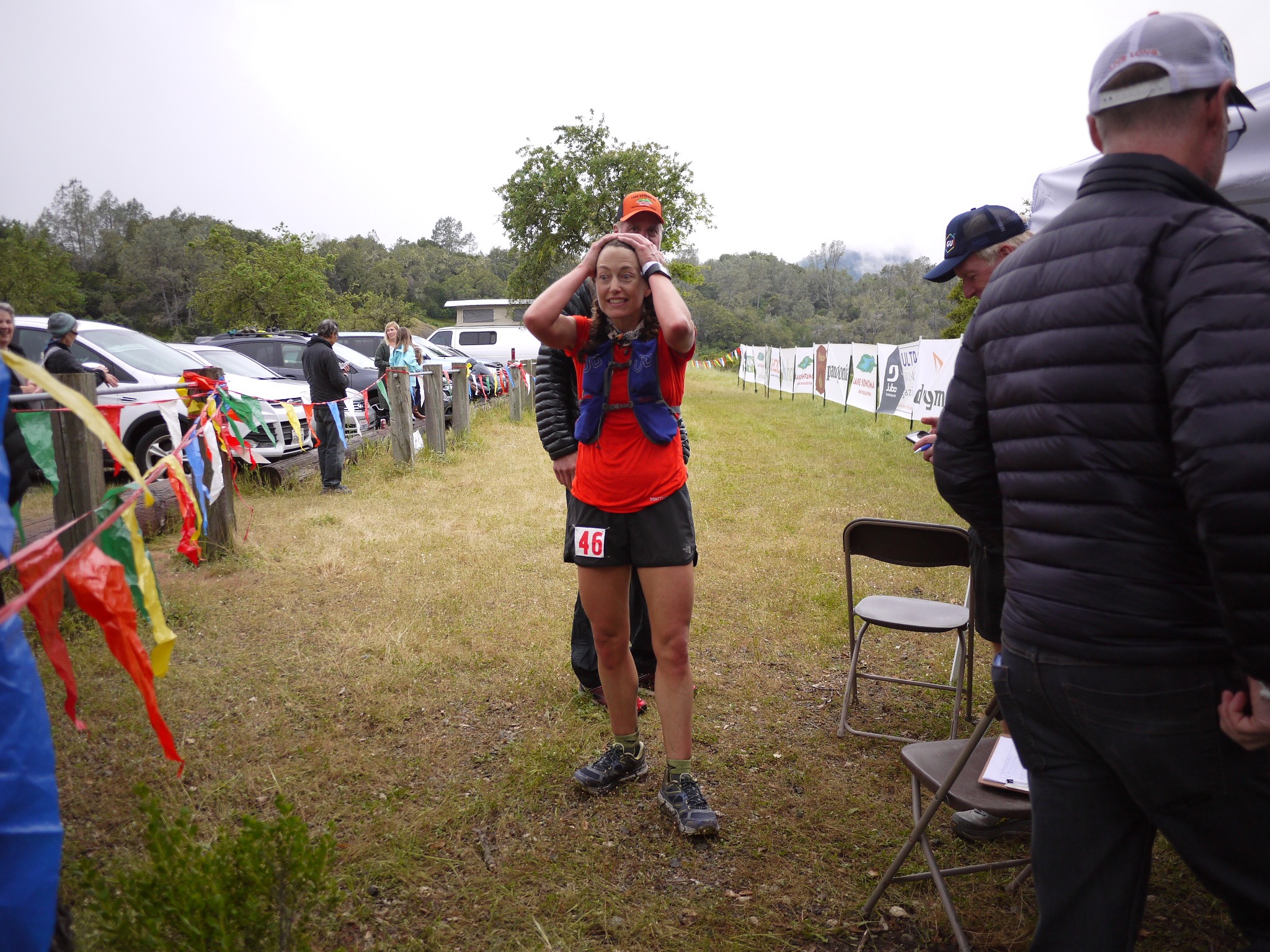
Eric Schranz snapped this right after I finished. I shared it online and asked for caption suggestions. My favorites: “Where are my car keys?” (Martin Whitcomb and Mike Harms), “What? It’s only a 50?” (Sarah Duffy), “I’m sure I was wearing a hat” (Penny Macphail), and my favorite, by Allen Lucas, “What do you mean, all you have left is Coors Light???”
To answer the first line of this post: How have I changed in three years?
Training: Similar mileage for peak weeks (topping out around 70 mpw), but I ran significantly more mileage 4 – 8 weeks out from this year’s race compared to 2013; I also had two good, strong 50K races leading up to it (Sean O’Brien in early February and Marin Ultra Challenge in mid-March), whereas in 2013 I only ran Way Too Cool 50K in early March. More significantly, I now religiously do upper-body strength conditioning at least three times weekly (with an emphasis on core/glute but also arms) along with PT (ankle/foot care and a lot of balance work). I also did this in 2013, but not as consistently. Additionally, starting this past year, I routinely do plyometrics and hill or stair repeats at the end of a hard-effort midweek run (which is usually some form of a speed workout).
Form: In the second half of 2013, I took many months off from running to heal various interrelated glute and hip problems, a metatarsal stress fracture, and a severely inflamed ligament in my big toe. Flaw in my form aggravated those problems, so starting in 2014, I really worked on running differently: with an engaged core, forward lean, quicker and lighter turnover, and feet more parallel than turned out and overpronating. I tried to mimic the feeling of riding a bike while running, imagining my feet parallel in pedals and smoothly rotating with my knee always bent and in the lead; and my footstrike a soft, glancing blow that lands directly under my body, rather than a hard strike and pushoff that lands out in front. This helped eliminate the common problem of overstriding and landing with my leg too straight and posture too upright. Not only can I feel the difference; I can hear it, because my footstrike is quieter now, which means I land with less impact—and that’s gotta be a good thing for my body. I also worked on arm swing, to eliminate inefficiencies and get as much power and fluidity from my upper body as possible.
Gear: I much prefer my hydration system to what I used three years ago. I used to run with a single 20-oz. hand-held bottle, which contributed to imbalanced form; and/or a vest with a reservoir in back. (For ultras, I’d have a bottle in both hands—but this didn’t feel great.) I much prefer hands free and bottles on shoulder straps, easy to access for refill (unlike a reservoir in back that has to be pulled out). I love the vest I use now (details and review).
Shoes: Back then I used Asics. Then I became a Hoka convert. More recently I tried Altras. Jury is out on Hokas vs. Altras; I prefer Hoka’s profile and cushioning to Altra’s, but Altra’s toe box works better for me. I’m going back and forth between them now.
Socks: In 2013 I often raced with knee-high compression socks. Now I just use compression socks for day-after recovery. For racing and training runs, my favorite sock is the Drymax 1/4-crew trail running sock. No slippage, no blisters. (Thanks Bob MacGillivray!)
Weight and nutrition: I was four pounds lighter for this LS50 than the 2013 edition. I continue to feel good about the nutrition makeover I gave myself around new year’s.
Race and training fuel: I recently switched from Gu to VFuel and prefer it (though I had a few Gus from aid stations at this LS50). In 2013 at LS50, I ate some “real food” like PB&J during the race from aid stations. This year, I stuck to VFuel or Gu gel, approx 1 – 2 per hour; sports drink and soda at aid stations; one Honey Stinger Waffle midway, a couple of Gu Chomps packets from aid stations, and that’s it. Having this quick-burning simple sugar, rather than eating more substantially, likely helped me race faster and lighter. I ate as if I were racing a marathon or 50K rather than a 50M. However, I definitely flirted with bonking toward the end, so that fueling strategy worked for 9 hours but was not sustainable. I plan to maintain a slower pace and eat real food throughout the day for Western States 100; otherwise I will be depleted by sundown!
Big congrats to top-three women YiOu Wang (7:14), Kaci Lickteig (7:22) and Anna Mae Flynn (7:28). Full results here.
Here is a really well-done two-minute video montage of the 2016 Lake Sonoma 50 by Billy Yang. Check it out:
Huge thanks to: RD Tropical John for a first-rate event and outstanding goodies like the Patagonia jacket; TJ’s merry hard-working band of The Rocket, Lisa Henson, Scott Mills, Stan Jensen and all the volunteers; Eric Schranz, Meghan Hicks, Chris Jones, Billy Yang, Joseph Condon, Emily Yu and others who took photos along the course and shared them afterward; all the Tahoe/Truckee runners like Gretchen Brugman, Chaz Sheya, Chris Perillo and others who welcomed me to their table that Friday night; Heather Sutherland for making me feel so satisfied and proud as a coach; and my husband Morgan, who encouraged me and continues to enthusiastically support my training this season.

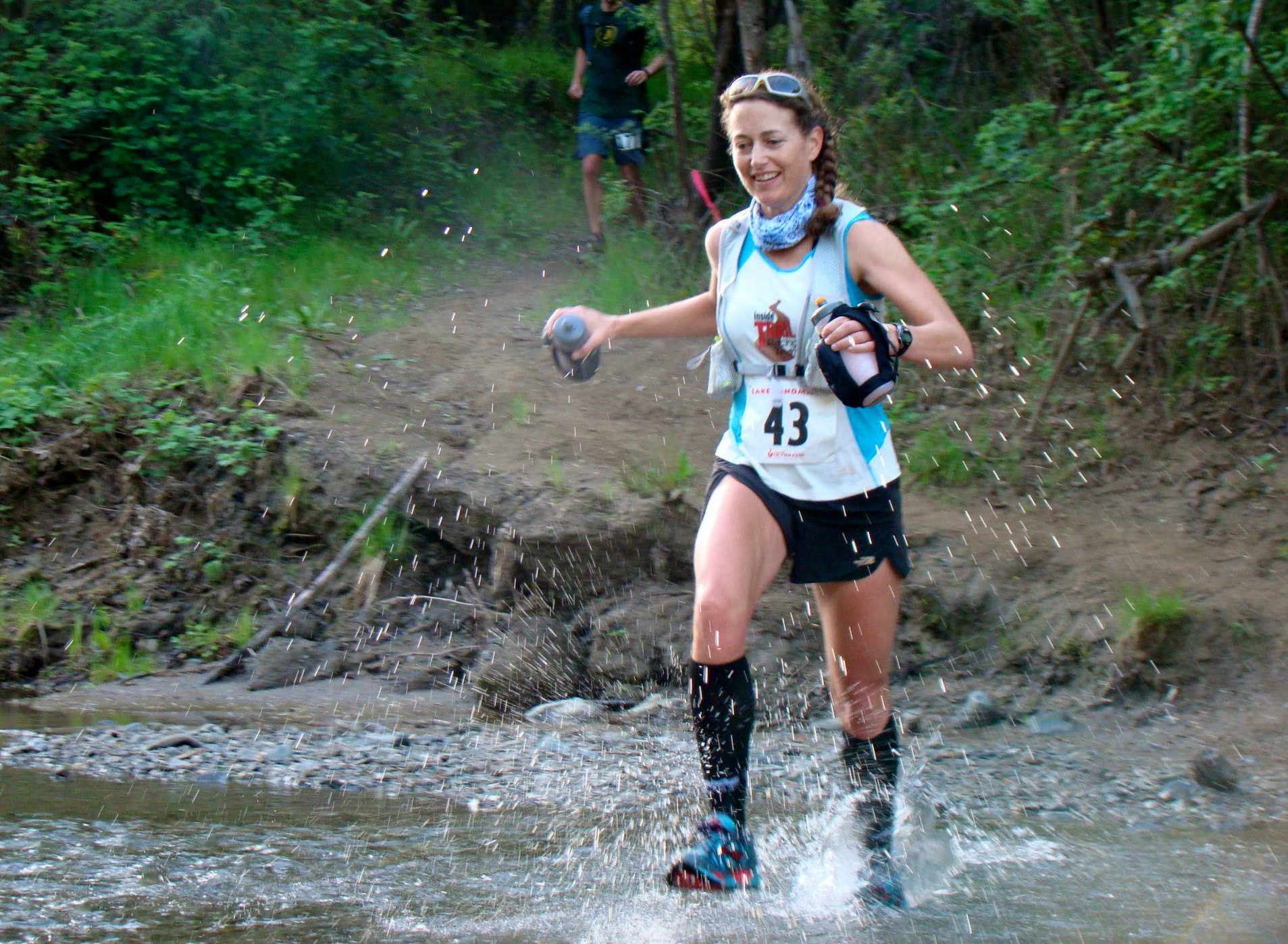
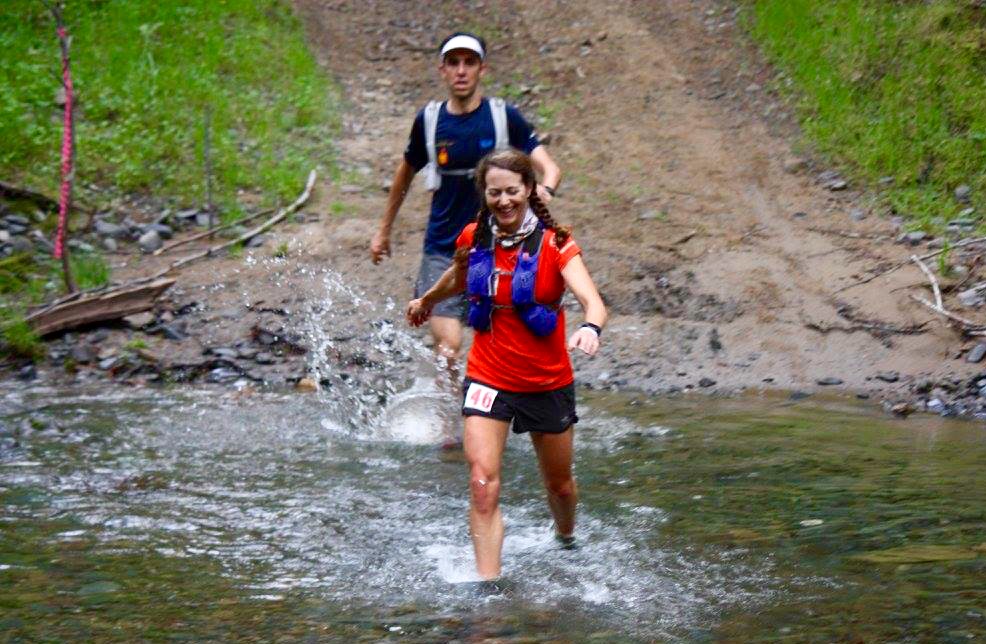
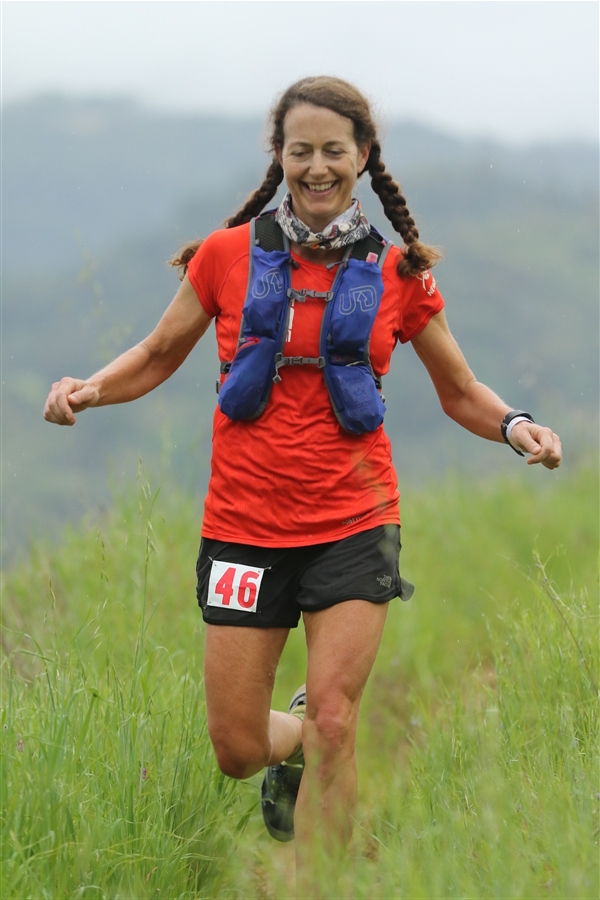

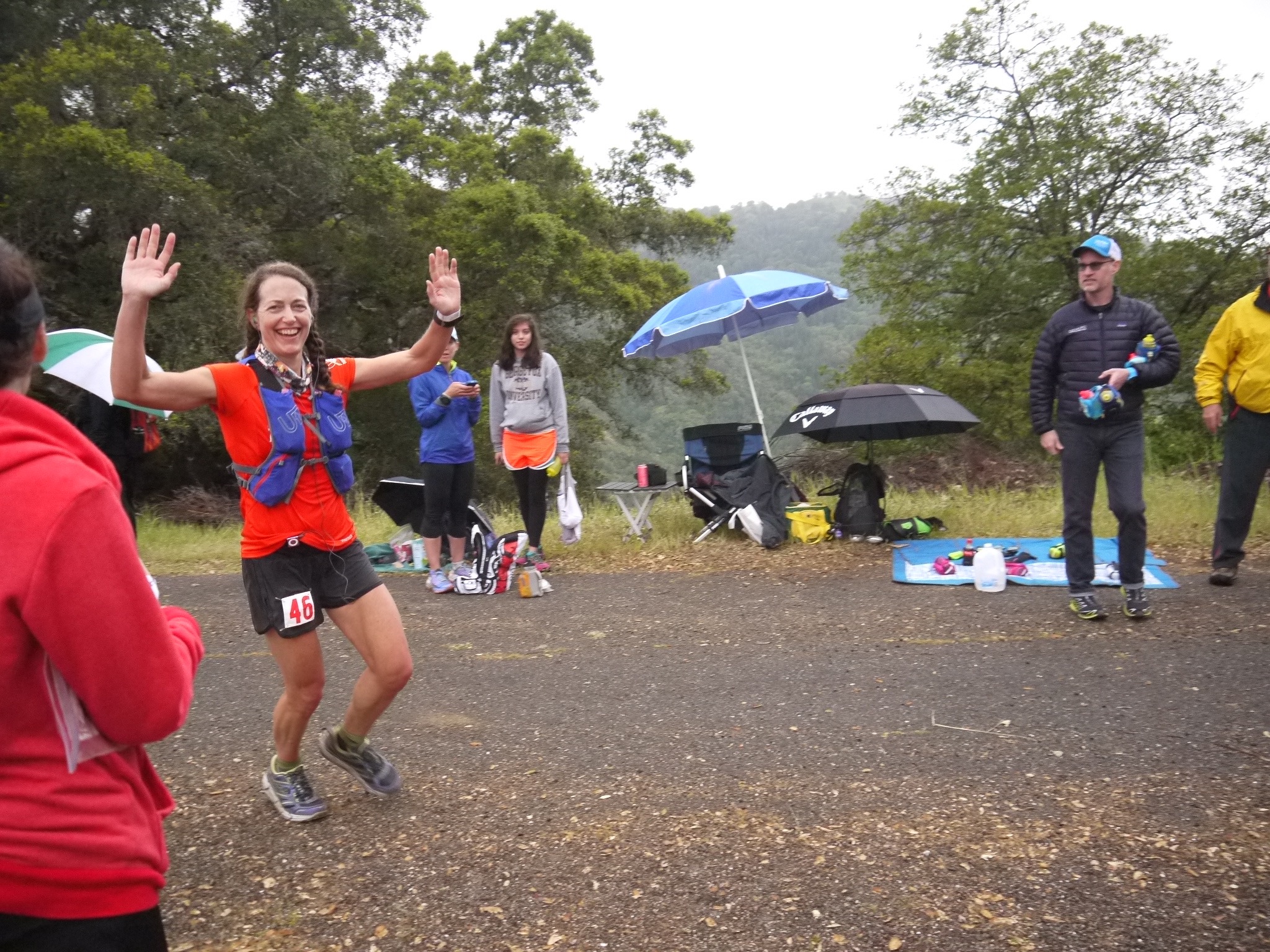
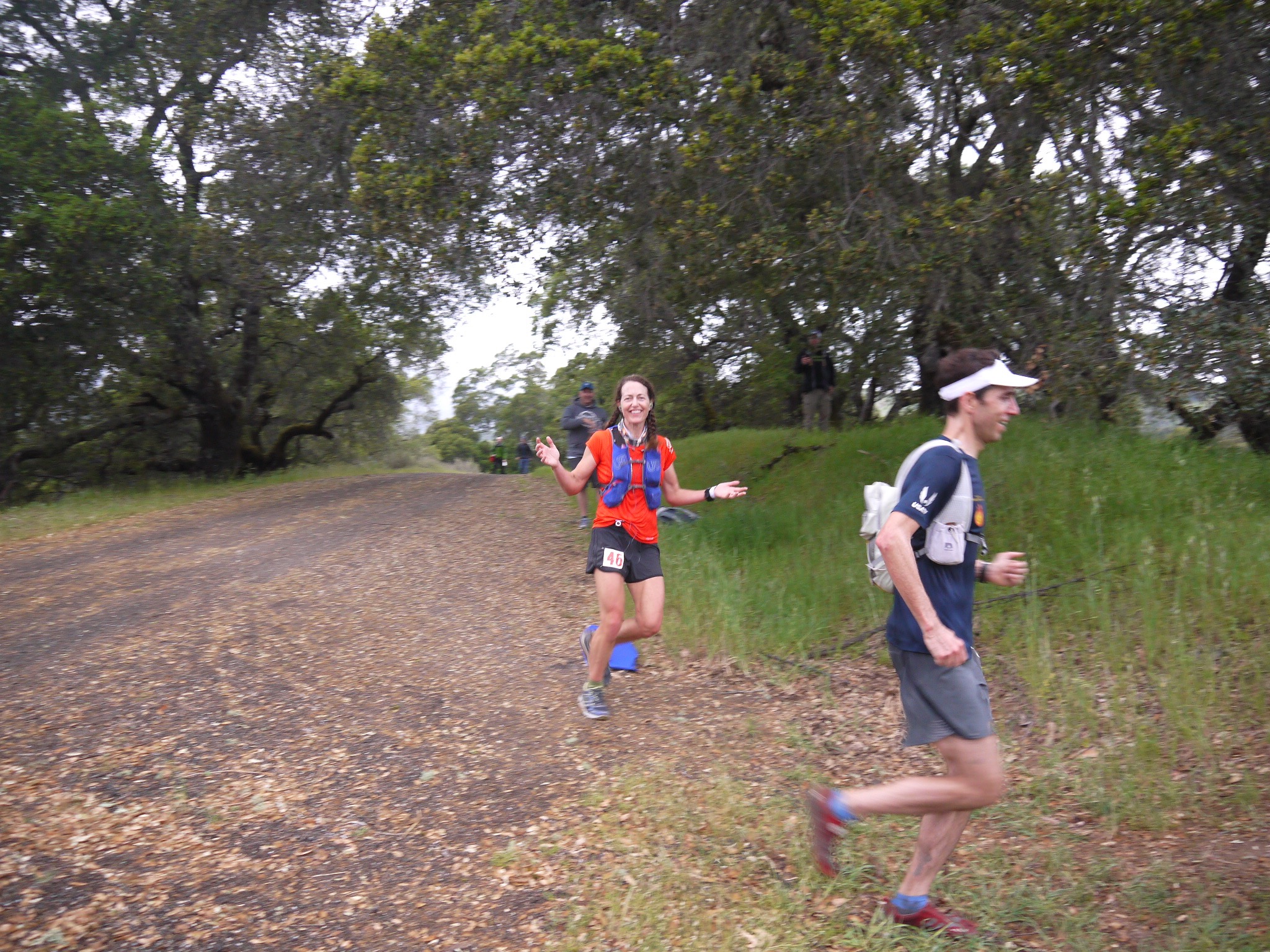
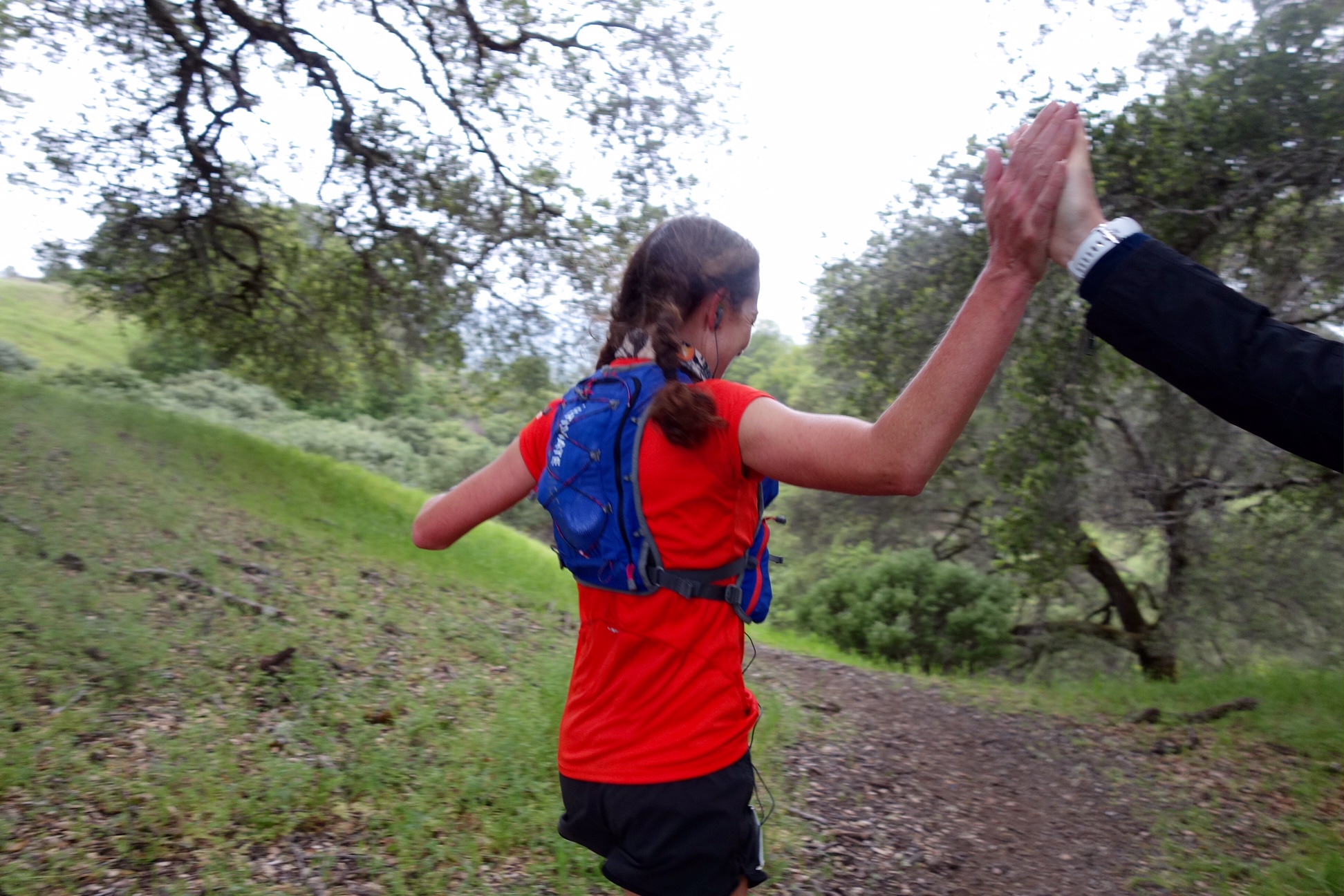
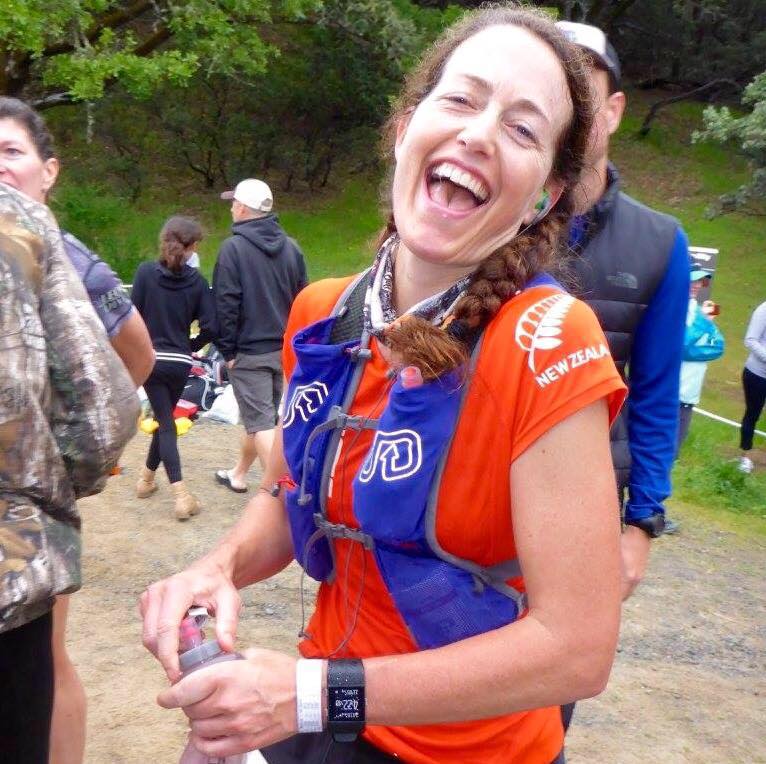
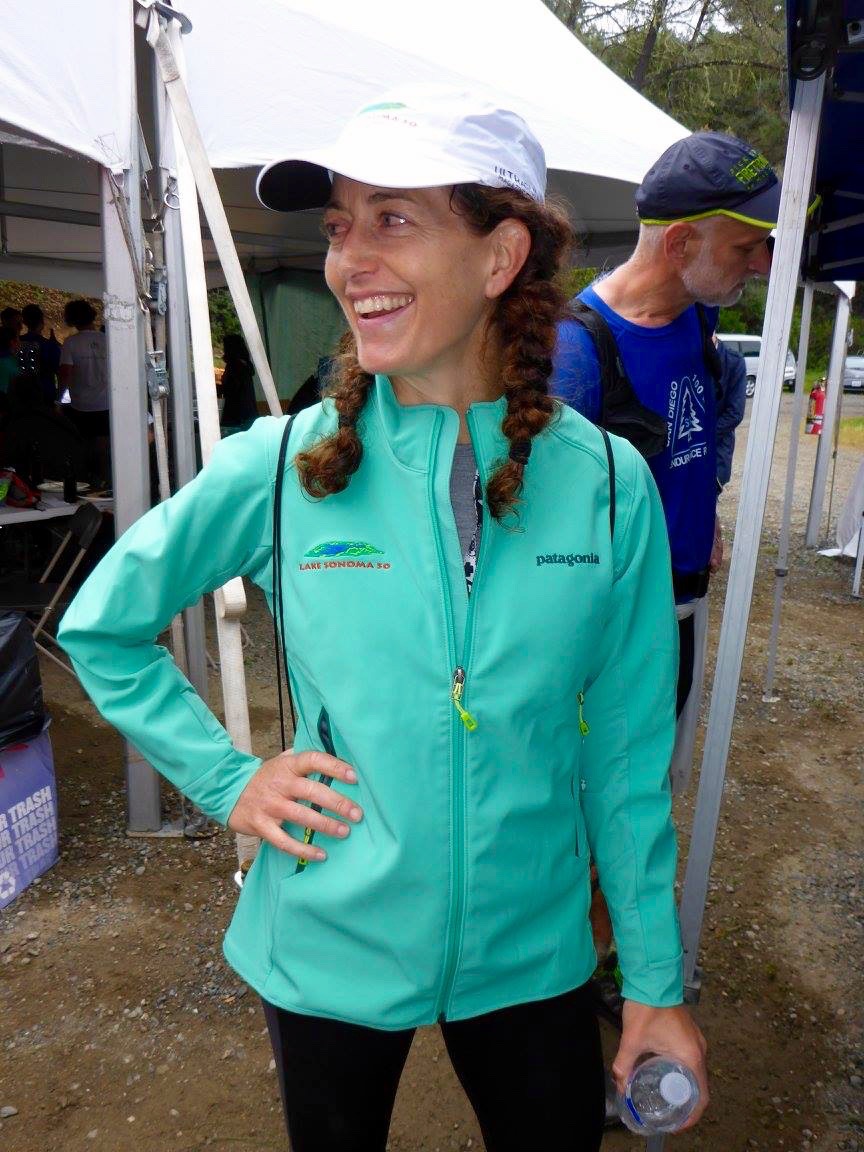
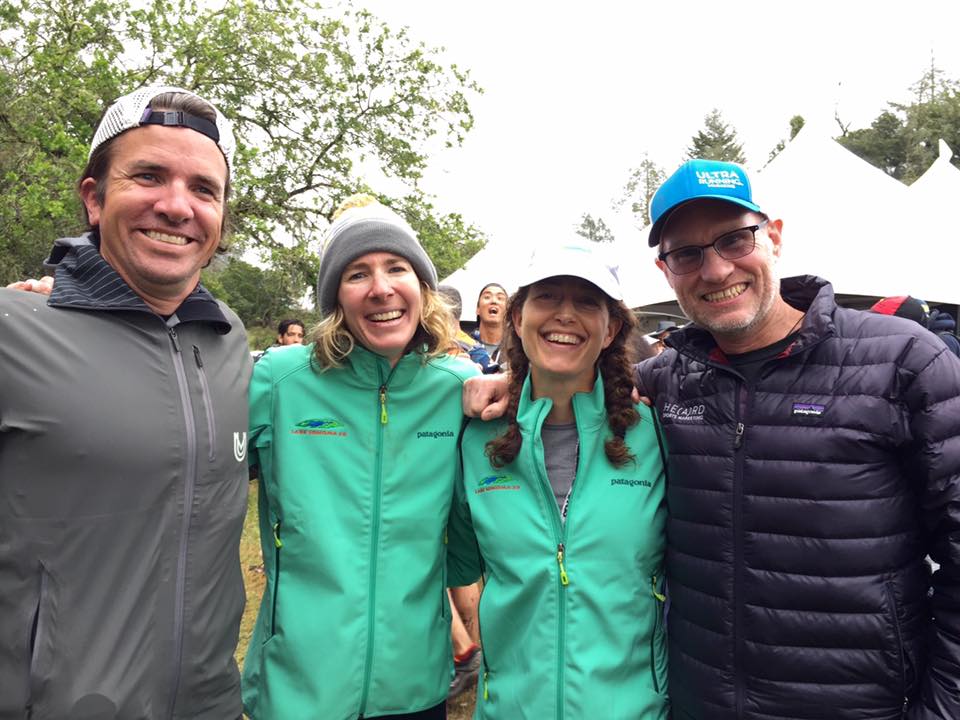
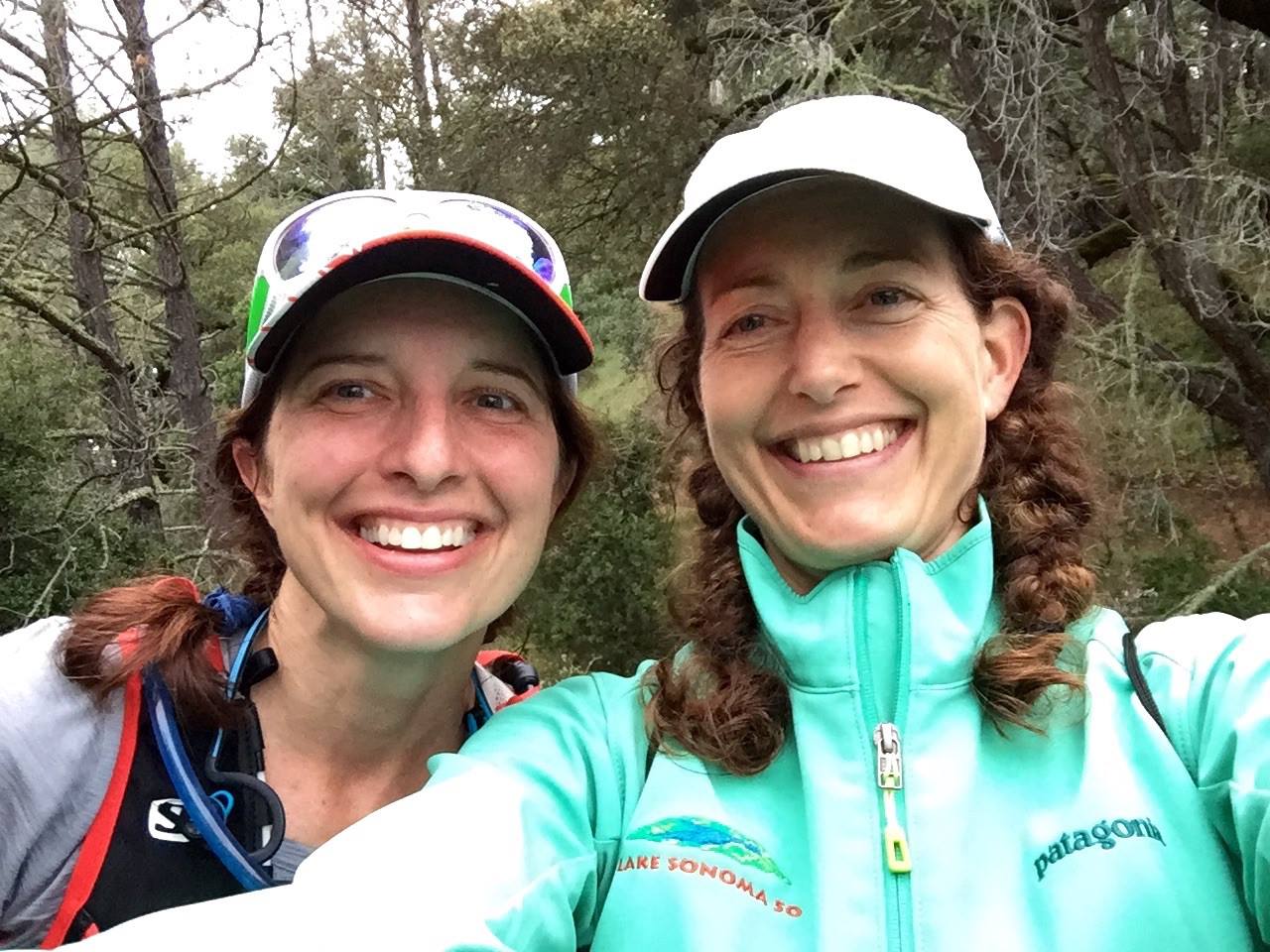
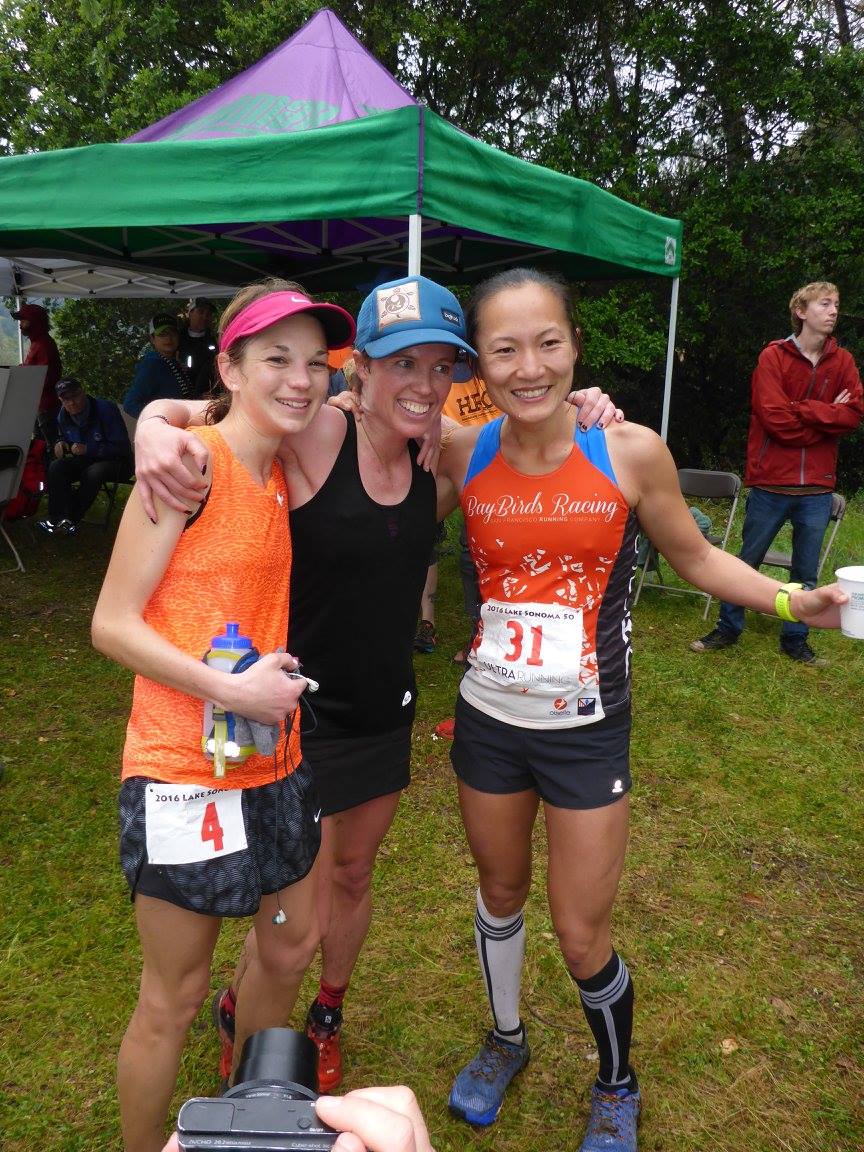
Great report! As I fellow almost 46 year old I too embrace my age and yet at the same time want some new pr’s. Keep up the amazing work!
Congrats on the super speedy finish! I’m turning 40 soon, so I’m glad to see that we can get faster and better with age! Great report!
What an inspirational and educational piece!! I love how you explain the differences between your first Sonoma to this. And, I respect a competitive person who shows transparency in their feelings. Doing so shows me that I’m
Not the only one with those voices in my head. Congratulations on a very well deserved finish! Oh man, I can’t wait to run my next race!
This is a great recap and view into your thought process while approaching a race like this. Very encouraging with WESR 100 on the horizon – it sounds like you are right on track for that race. Congrats on such a huge improvement!
Great run, Sarah! You improved steadily over the years, no question asked. Looking forward your WS!
Getting old is the greatest challenge. All the other challenges of the human condition are easy.